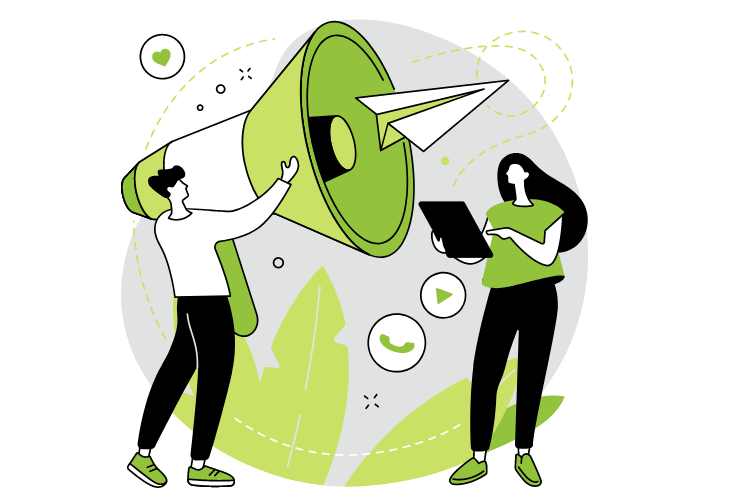5 Best Email Automation Strategies to Boost Conversions
Email automation is a powerful weapon in your marketing arsenal, intended to target your customers based on their behavior and preferences. With marketing automation tools like segmentation, drip campaigns, and triggers, you can send personalized and relevant marketing emails that resonate throughout the customer journey. In practice, this should translate to increased lead conversions, a higher customer retention rate, a better overall customer experience, and more revenue for your business via email marketing automation.
With data and analytics, you can also track the behavior of your subscribers and use that information to optimize your email automation sequence.
Before we dive into automated email best practices, let’s understand what makes for a good conversion rate.
What Is a Good Conversion Rate?
To answer this question, you first need to define your business goals. If you’re looking to generate leads, an average conversion rate is around 2 to 5%. 6 to 9% is above average, and anything over 10% is considered good. A good conversion rate will be about 10 to 15% if you sell products or services. That said, you should continually strive to have the highest conversion rate possible for your business.
Since an email marketing strategy can be a hit or miss depending on the execution, the quality of the leads, etc., it becomes imperative to optimize your campaigns for maximum conversion rate meticulously.
Here is your ultimate guide to the 5 best email automation strategies to boost Conversion Rate Optimization (CRO) from the customer viewing the email to purchasing the product/service.

1. Start capturing data
By capturing data on your subscribers’ behavior and preferences, you can create more targeted and personalized emails that are more likely to convert. Progressive profiling captures more data about your subscribers over time. Instead of asking for all the information upfront, ask for additional information gradually as your subscribers interact with your emails or website.
a) Monitor purchase history
One effective email marketing automation strategy to boost conversions is to monitor your customer’s purchase history. By keeping track of what they have previously bought, you can offer products or services that they are likely interested in purchasing.
Upsell/cross-sell emails: Send automated emails to customers who have previously purchased a product or service by offering them complementary products or upgrades. For example, if a customer buys a camera, you can offer them a lens or tripod.
Abandoned cart emails: If a customer adds items to their cart but doesn’t complete the purchase, send them a reminder email with the items they left behind. You can also offer a discount or free shipping to encourage them to complete the purchase.
Replenishment emails: If a customer regularly buys a specific product, you can send them a reminder email when it’s time to replenish it. This is particularly effective for consumables such as food or skincare products.
Exclusive offer emails: Send special offers to customers based on their purchase history. For example, if a customer frequently buys shoes from your store, send them a discount code for shoes.
Post-purchase emails: Send a follow-up email after a customer has made a purchase, thanking them for their business and offering product recommendations or services that may interest them.
2. Craft compelling subject lines
Your subject line is your CTA for opening the email. An actionable subject line is more convincing and attractive to readers, and your email messages will be more clickable.
Keep it short and sweet: With more email opens being made on mobile, your subject line should be concise and to the point. Most email clients display only the first 50 characters of a subject line, so make sure your message is clear and compelling within that limit.
Use numbers and emojis: Numbers and emojis can grab attention and make your subject line stand out. You can use numbers to promote your listicle article, the offer you’re sending, a discount, or an exact number of important resources. For example, “5 ways to boost your productivity 💪” or “50% off everything in store 🎉”.
Ask a question: Asking a question in your subject line can pique your subscribers’ curiosity and encourage them to open your email. For example, “Are you making these common marketing mistakes?” or “Want to know the secret to a successful business?”.
Create urgency: Use urgent language in your subject line to create a sense of urgency and encourage your subscribers to act. For example, “Last chance to save 30%!” or “Limited time offer: Act now!”.
Make it relevant: Show your subscribers that they’re an integral part of your community by using personalization when you automate emails, such as addressing them by name or referencing their recent activity, such as their last purchase or website visit.
Use power words: Use strong and persuasive words in your subject line to grab attention and create an emotional response. For example, “Unlock the secrets to success” or “Transform your life with this simple strategy.”

3. Promote sign-up opt-in forms
Promoting your email sign-up forms is crucial for growing your subscriber list and increasing conversions.
Welcome opt-ins: Revealed when a person first enters the website.
Lightbox pop-ups: Can be shown on any page that briefly blurs the rest of the content until a prospect decides whether to leave their email or exit the opt-in form.
Exit intent pop-ups: When a prospect leaves your website, it’s the best time to offer a lead magnet in exchange for their email address and other relevant information.
Incentives, such as a free trial, e-book, checklist, or webinar, can encourage more visitors to sign up and provide you with valuable data and leads.
Social media and paid advertising: Use social media to drive more traffic to your sign-up form and encourage your followers to sign up. Use social media ads and paid advertising, such as Facebook and Google Ads, to target new audiences interested in your products or services.
Add sign-up forms to your email signature: Add a link to your email sign-up form in your email signature. This can promote your email sign-up form to everyone you email and increase your chances of gaining new subscribers.
Include a sign-up form on your blog: Include a sign-up form on your blog to encourage your readers to sign up. Offer exclusive content or resources to those who sign up to incentivize them further to join.
4. Invest in a CRM
A Customer Relationship Management (CRM) system for email automation is a valuable business investment. A CRM system allows you to create timely and relevant trigger-based emails sent automatically when a subscriber takes a specific action, such as signing up for your email list or purchasing. This can help you save time, manage your customer data effectively, and increase the effectiveness of your email marketing campaigns.
Automated workflows and triggered emails: An email workflow serves the purpose of lead nurturing and plays an essential role in the inbound methodology. Besides the conventional triggered eCommerce email campaigns that include:
- a welcome email series,
- post-purchase follow-up sequences,
- browse and cart abandonment campaigns, and
- customer re-engagement campaigns, you can also automate different email responses like a subscription confirmation or “Thank you” message. Also, consider cross-channel marketing, optimizing the design of carbon-copied email templates, the sales process, and a more discreet customer reactivation email with a discount.
Personalization: A CRM system lets you personalize your emails based on your subscribers’ behavior and preferences to make them more relevant and engaging.
Segmentation: In today’s world, users constantly receive information and content at their fingertips. A CRM system allows you to send targeted emails to specific groups of subscribers based on various criteria such as demographics, interests, and behavior. Mastering this strategy lets you give your prospects and customers what they want when they want it.
Analytics: A CRM system provides detailed analytics on your email campaigns, including open rates, click-through rates, and conversion rates. This allows you to track the effectiveness of your campaigns and make data-driven decisions to optimize your email marketing strategy.
Integration: To create a seamless marketing workflow, a CRM system can be integrated with other marketing and email automation tools, such as social media management and automation platforms, landing page builders, and email automation software.
5. Review your KPIs
Conversion rate metrics are defined as the percentage of people completing a desired action, from purchasing to subscribing to your blog. Your overall conversion rate is determined by how well your email performs compared to other marketing channels.
To know whether your email marketing works, you must measure key metrics. The metrics that you’ll quantify depend on your email marketing goals. The most significant KPIs are:
Click Through Rate (CTR): The ratio of people that clicked on your links to the number of people who opened the email.
[number of users who clicked % number of email opens] x 100
Conversion Rate: Every time an email reader makes the desired action after they click on your link.
(number of people who made the desired action) % (number of opened emails)
Bounce Rate: An email bounce happens if an email cannot be delivered.
1 – [(number of delivered emails) % (number of sent emails)]
List Growth: Keep track of your growth rate to gauge whether your automated email marketing campaign is successful.
([(number of new subscribers) – (number of unsubscribes + spam complaints)] % Total number of email addresses on your list]) x 100
Sharing Rate: The percentage of people that shared or forwarded the email.
(number of people that shared/forwarded message) % (number of opens)
ROI: Your total revenue divided by your spending.
[[(money made in additional sales) – (money that is invested in email marketing)] % (money spent on the email campaign)] X 100
Ready to create your email automation workflows and reap the rewards of inbound marketing?
Marketing automation isn’t all about attracting new customers. A fundamental way to boost revenue is by getting existing customers to spend more throughout their lifetime with your brand.
Email automation helps make customer retention and loyalty strategies a breeze. It allows you to automate feedback requests, send exclusive offers to high-spenders, and trigger re-engagement campaigns if subscribers stray.
These tactics strengthen customer lifetime value by delivering the right message to the right people at the right time.
Contact the bLoyal sales team or request a demo for more about the benefits of email automation and how to streamline these automated email strategies on our centralized loyalty marketing platform!




